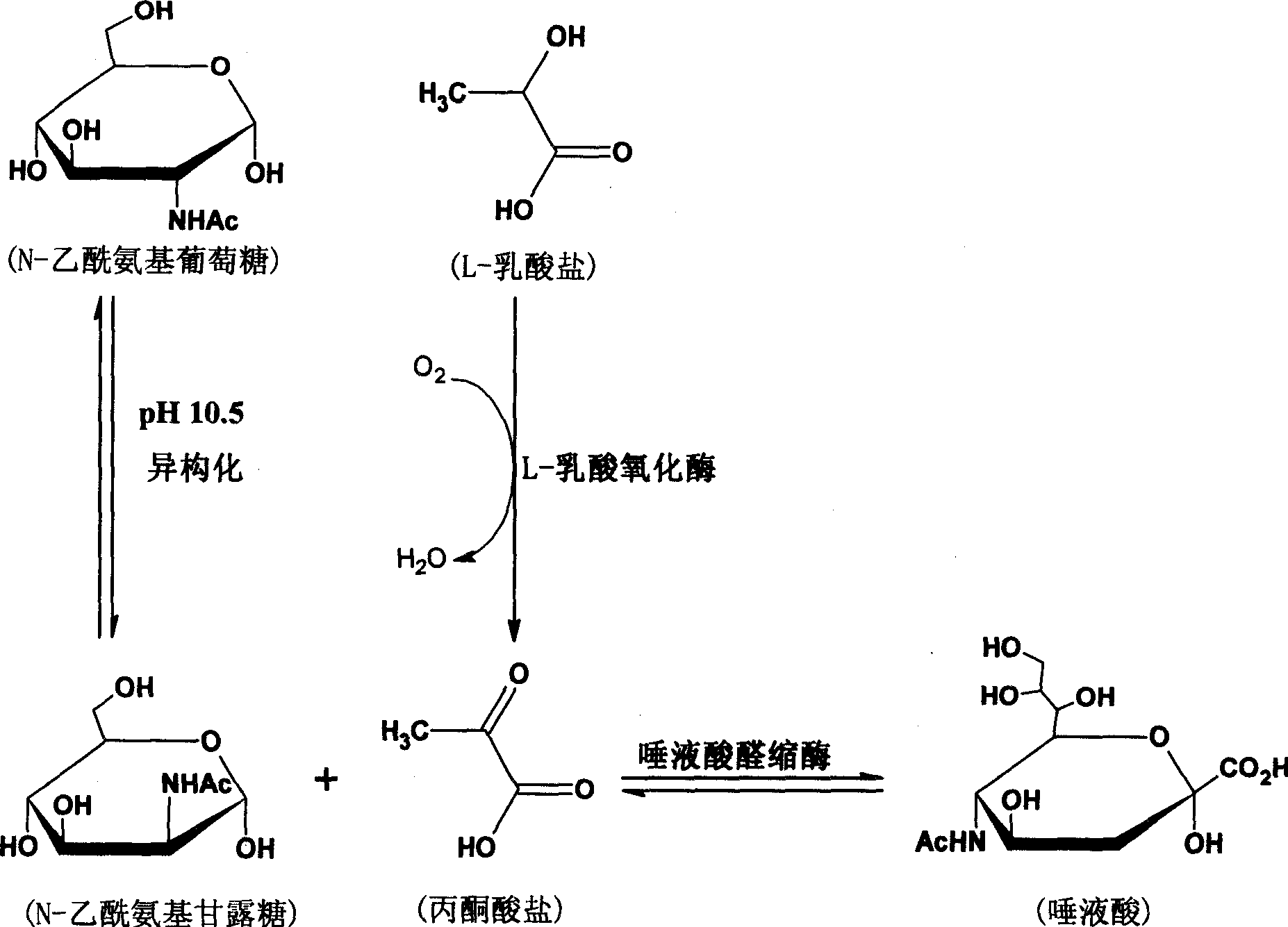Preparation of valuable sialinic acid from cheap sodium lactate by multi-step coupling bio-conversion
A technology of biotransformation and sodium lactate, applied in the direction of fermentation, bacteria, etc., can solve the problems of high production cost, high price, and increased cost
- Summary
- Abstract
- Description
- Claims
- Application Information
AI Technical Summary
Problems solved by technology
Method used
Image
Examples
Embodiment 1
[0081] Example 1: Cultivation of lactate oxidase-containing strains
[0082] 1. Culture of Pseudomonas sp. ATCC11452
[0083] (1) Lactate oxidase strain: select Pseudomonas sp. ATCC11452;
[0084] (2) Slant culture: Pseudomonas sp. ATCC11452 was inoculated on a solid slant basic medium containing 1.5% mass / volume agar and 1% mass / volume sodium L-lactate at 30°C cultured for 20 hours;
[0085] (3) Primary seed culture: the strains cultivated in step (2) were inoculated into 30 mL liquid basic medium BLM containing L-type sodium lactate with a mass-to-volume ratio of 1% under aseptic conditions, at 30° C. Under the condition of shaking culture on a shaker for 10 hours, first-class seeds were obtained;
[0086] (4) Expanded culture: with an inoculation amount of 5% by volume, the first-class seeds were placed in 500 mL of BLM containing 2% by volume of L-type sodium lactate, and under the condition of 30° C., shaken and cultured on a shaking table for 16 hours to prepare seco...
Embodiment 2
[0104] Example 2: Construction of engineering strain E. coli HB101 (pBV220-ALD)
[0105] Construction of sialyl aldolase strain: Escherichia coli engineering strain, namely E.coli HB101 (pBV220-ALD), was constructed by conventional methods:
[0106]Construction of recombinant engineering strains: Genomic DNA of E.coli K12 strains was prepared by conventional methods. This process can be referred to the method of small-scale preparation of bacterial genomes in the "Guidelines for Molecular Biology" published by Science Press to extract E.coli K12 strains. Genomic DNA of the coli K12 bacterial strain; use synthetic primers to amplify the sialic acid aldolase gene from the genomic DNA of the E.coli K12 bacterial strain; The sialic acid aldolase gene was connected to obtain the recombinant plasmid pBV220-ALD; then the recombinant plasmid pBV220-ALD was transformed into the vector E.coli HB101 to obtain the engineering strain E.coli HB101 (pBV220-ALD);
[0107] Wherein the host is...
Embodiment 3
[0108] Embodiment 3: the cultivation of engineering strain Escherichia coli E.coli HB101 (pBV220-ALD)
[0109] (1) Plate culture: Streak the engineering strain Escherichia coli HB101 (pBV220-ALD) on an ampicillin LB plate containing 100 μg / mL of 1.5% agar in mass volume ratio, and culture at 30° C. for 12 hours;
[0110] (2) First-class seeds: under sterile conditions, use a sterile toothpick to pick a single colony on the plate of step (1), and then inoculate it into 5 mL of liquid medium containing 100 μg / mL ampicillin, for 30 Cultivate with shaking in a shaker for 12 hours;
[0111] (3) Secondary seeds: under aseptic conditions, take the culture solution cultivated in step (2) with a volume ratio of 2% inoculum, inoculate into 240 mL of LB liquid medium containing 100 μg / mL of ampicillin, 30°C shaker culture for 6 hours;
[0112] (4) fermentor culture: under aseptic conditions, get the nutrient solution obtained in step (3) to inoculate the improved M9 liquid medium of 3L...
PUM
 Login to View More
Login to View More Abstract
Description
Claims
Application Information
 Login to View More
Login to View More - R&D
- Intellectual Property
- Life Sciences
- Materials
- Tech Scout
- Unparalleled Data Quality
- Higher Quality Content
- 60% Fewer Hallucinations
Browse by: Latest US Patents, China's latest patents, Technical Efficacy Thesaurus, Application Domain, Technology Topic, Popular Technical Reports.
© 2025 PatSnap. All rights reserved.Legal|Privacy policy|Modern Slavery Act Transparency Statement|Sitemap|About US| Contact US: help@patsnap.com



